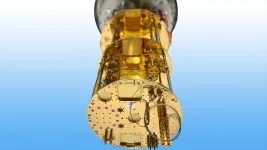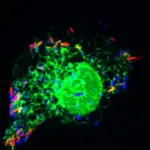Do purines influence cancer development?
2021-05-10
(Press-News.org) Numerous disease development processes are linked to epigenetic modulation. One protein involved in the process of modulation and identified as an important cancer marker is BRD4. A recent study by the research group of Giulio Superti-Furga, Principal Investigator and Scientific Director at the CeMM Research Center for Molecular Medicine of the Austrian Academy of Sciences, now shows that the supply of purines as well as the purine synthesis of a cell can influence BRD4 activity and thus play a role in the carcinogenesis process. The findings were published in Nature Metabolism.
Chromatin is a central component of the cell nucleus. It refers to the complex of the approximately two-meter-long human DNA with proteins that organize it so that - depending on the cell type - certain genes are activated or deactivated. In order to be able to adapt to diverse situations and influences, cells read the information relevant to them from the DNA. If this process is disturbed, diseases such as cancer develop. Scientists have been researching for many years what influences this process. The protein BRD4, which makes a decisive contribution to the unpacking and packaging of DNA in chromatin, was identified as a marker for cancer. Since then, scientists have been investigating how BRD4 can be modulated. A recent study by scientist Kai-Chun Li and the research group of CeMM Scientific Director Giulio Superti-Furga makes an important contribution to answering this question. She investigated how certain externally supplied nutrients, so-called purines, influence BRD4 and thus the development process of various cancer diseases. Purines are basic building blocks of the cell. Disturbances of the purine metabolism in the cell have already been associated with some disease patterns in the past. The study showed, on the one hand, that inhibiting purine supply as well as disturbing purine synthesis can trigger a functional disturbance of BRD4 and thus impact chromatin accessibility. On the other hand, BRD4 functionality could be restored by adding adenine.
Analysis of the transport pathways
Giulio Superti-Furga's research group focuses particularly on those transport proteins in the genome that transport numerous important substances such as nutrients and metabolites into and out of the cell - so-called solute carriers (SLC). First author Kai-Chun Li explains: "Our aim was to investigate the involvement of SLC-mediated purine uptake and cellular metabolism in the modulation of cellular epigenetic states, because purine metabolism plays an essential role in cell metabolism." With the help of SLCs, the scientists were able to modulate the purine supply for their study and observe the direct effects. They used both a genetic screening based on a CRISPR/Cas9 library focused on transporters, and a drug screening using a compound library mainly consisting of cellular metabolites and drugs, both to track down the modulation of BRD4-dependent chromatin states in myeloid leukemia cells. The scientists compared "normal" cancer cells with those cancer cells in which the SLCs that transport purines were inhibited. In addition, purines were added to or omitted from the growth medium of the cells in various experiments, thus modulating purine biosynthesis in the cells.
Adenine brings BRD4 back into balance
The study shows that an imbalance of intracellular purine pools leads to a dysfunction of BRD4-dependent transcriptional modulation of chromatin, which means that the correct reading of DNA information is disturbed. "These results demonstrate a pharmacologically effective axis between purine metabolism and BRD4-dependent chromatin states," explains study leader Giulio Superti-Furga. Drugs that influence BRD4 have already been developed in the past. At the same time, some cancer types also became resistant to such BET inhibitors. "With our study, we show another way to modulate BRD4 - by influencing the purine metabolism." The scientists also found an answer to the question of how BRD4 functionality could be restored: they were able to show that adenine, a purine-derived compound, plays a strong role in BRD4 interaction. "Our results suggest that adenylates (adenine, ATP, etc.) are important for healthy cells. This could be a significant starting point for developing new therapies against BRD4-induced cancer types," says Superti-Furga.
INFORMATION:
The study "Cell-surface SLC nucleoside transporters and purine levels modulate BRD4-dependent 2 chromatin states" was published in Nature Metabolism on May 10, 2021, DOI: 10.1038/s42255-021-00386-8.
Authors: Kai-Chun Li, Enrico Girardi, Felix Kartnig, Sarah Grosche, Tea Pemovska, Johannes W. Bigenzahn, Ulrich Goldmann, Vitaly Sedlyarov, Ariel Bensimon, Sandra Schick, Jung-Ming G. Lin, Bettina Gürtl, Daniela Reil, Kristaps Klavins, Stefan Kubicek, Sara Sdelci, Giulio Superti-Furga
Funding: CeMM and the Superti-Furga and Kubicek laboratories are supported by the Austrian Academy of Sciences. They were supported by third-party funds from the Austrian Science Fund, the European Research Council, the European Commission (Marie 437 Skodowska-Curie Action Fellowship) and an EMBO long-term Fellowship. Sarah Grosche is supported by the Peter and Traudl Engelhorn Foundation. Research in the Kubicek lab is supported by the Austrian Science Fund (FWF F4701) and the European Research Council under the European 440 Union's Horizon 2020 research and innovation programme (ERC-CoG-772437).
Giulio Superti-Furga is Scientific Director of CeMM, and Professor of Medical Systems Biology at the Medical University of Vienna. He was trained as a molecular biologist at the University of Zurich, Genentech, IMP Vienna and EMBL Heidelberg. He obtained four grants from the European Research Council, is a member of five scientific academies, and has published more than 200 papers. CeMM, which he has been directing since 2005, is located in the middle of the large general hospital campus in Vienna, where, together with some 180 scientists and medical doctors, he brings genomic and systems views close to the clinical world with a view to improving medical practice. For CeMM, he promoted a unique mode of super-cooperation, connecting biology with medicine, experiments with computation, discovery with translation, and science with society and the arts. Recent interests include ways to create functional precision medicine approaches and the role of the human transportome in pathophysiology and drug discovery. He is the scientific coordinator of the Innovative Medicine Initiative consortium "RESOLUTE", dedicated to the deorphanization of SLC transporters.
The mission of CeMM Research Center for Molecular Medicine of the Austrian Academy of Sciences is to achieve maximum scientific innovation in molecular medicine to improve healthcare. At CeMM, an international and creative team of scientists and medical doctors pursues free-minded basic life science research in a large and vibrant hospital environment of outstanding medical tradition and practice. CeMM's research is based on post-genomic technologies and focuses on societally important diseases, such as immune disorders and infections, cancer and metabolic disorders. CeMM operates in a unique mode of super-cooperation, connecting biology with medicine, experiments with computation, discovery with translation, and science with society and the arts. The goal of CeMM is to pioneer the science that nurtures the precise, personalized, predictive and preventive medicine of the future. CeMM trains a modern blend of biomedical scientists and is located at the campus of the General Hospital and the Medical University of Vienna. http://www.cemm.at
[Attachments] See images for this press release:

ELSE PRESS RELEASES FROM THIS DATE:
2021-05-10
New Curtin University research has found a bias among scientists toward colourful and visually striking plants, means they are more likely to be chosen for scientific study and benefit from subsequent conservation efforts, regardless of their ecological importance.
Co-author John Curtin Distinguished Professor Kingsley Dixon from Curtin's School of Molecular and Life Sciences was part of an international team that looked for evidence of an aesthetic bias among scientists by analysing 113 plant species found in global biodiversity hotspot the Southwestern Alps and mentioned in 280 research papers published between 1975 and 2020.
Professor Dixon said the study tested whether there was a relationship between research focus on plant species and characteristics ...
2021-05-10
In cancer, a lot of biology goes awry: Genes mutate, molecular processes change dramatically, and cells proliferate uncontrollably to form entirely new tissues that we call tumors. Multiple things go wrong at different levels, and this complexity is partly what makes cancer so difficult to research and treat.
So it stands to reason that cancer researchers focus their attention where all cancers begin: the genome. If we can understand what happens at the level of DNA, then we can perhaps one day not just treat but even prevent cancers altogether.
This drive has led a ...
2021-05-10
In the last few years, several technology companies including Google, Microsoft, and IBM, have massively invested in quantum computing systems based on microwave superconducting circuit platforms in an effort to scale them up from small research-oriented systems to commercialized computing platforms. But fulfilling the potential of quantum computers requires a significant increase in the number of qubits, the building blocks of quantum computers, which can store and manipulate quantum information.
But quantum signals can be contaminated by thermal noise generated by the movement of electrons. To prevent this, superconducting quantum systems must operate at ultra-low temperatures - less ...
2021-05-10
NEW YORK, NY (May 10, 2021)--Scientists have discovered that many esophageal cancers turn on ancient viral DNA that was embedded in our genome hundreds of millions of years ago.
"It was surprising," says Adam Bass, MD, the Herbert and Florence Irving Professor of Medicine at Columbia University Vagelos College of Physicians and Surgeons and Herbert Irving Comprehensive Cancer Center, who led the study published May 10 in Nature Genetics.
"We weren't specifically searching for the viral elements, but the finding opens up a huge new array of potential cancer targets that I think will be extremely exciting as ways to enhance immunotherapy."
Fossil ...
2021-05-10
DALLAS - May 10, 2021 - Scientists at UT Southwestern have discovered a key protein that helps the bacteria that causes Legionnaires' disease to set up house in the cells of humans and other hosts. The findings, published in Science, could offer insights into how other bacteria are able to survive inside cells, knowledge that could lead to new treatments for a wide variety of infections.
"Many infectious bacteria, from listeria to chlamydia to salmonella, use systems that allow them to dwell within their host's cells," says study leader Vincent Tagliabracci, Ph.D., assistant professor of molecular biology at UTSW and member of the Harold C. Simmons Comprehensive Cancer Center. "Better understanding the tools they use to make this happen is teaching us some interesting biochemistry and ...
2021-05-10
Many have assumed that the rates of major abdominal surgeries in adults over 65 is increasing over time as the U.S. population ages and as new technology renders surgical procedures safer for older adults. Contrary to this popular belief, a new study from the University of Chicago Medicine found the frequency of abdominal surgery in older adults is decreasing, especially among adults over the age of 85. The study, which examined data from 2002 to 2014, was published May 10 in the Journal of the American Geriatric Society.
While the research was not able to determine the exact reasons for this shift, the results indicate that improvements ...
2021-05-10
The relationship a dog has with its owner is related to its stress level. This is the conclusion of a newly published study from Linköping University, Sweden. The results, published in the journal Scientific Reports, also suggest that the link between stress and the owner's personality traits differs between dog breeds.
Researchers at Linköping University have investigated whether the stress levels of dogs are affected by the people they live with. Stress levels for the past several months can be determined in both dogs and humans by measuring the levels of stress hormone stored in hairs as they grow.
The researchers have collected hair from both dogs and owners, and measured levels of cortisol, the most important stress hormone, in them. They were interested in whether there ...
2021-05-10
For organizations to reach their potential, they must leverage the expertise of their employees. However, research demonstrates that lower-status employees may not be heard because their "voices" are more likely to be ignored.
New research from the University of Notre Dame is the first to show that peers can help boost marginalized voices, and at the same time benefit their own status, all while helping their organization realize the potential of its employees' diverse perspectives.
Publicly endorsing -- or amplifying -- another person's contribution, while giving attribution to that person, enhances the status of both parties, according to "Amplifying Voice in Organizations," ...
2021-05-10
Due to their complexity and microscopic scale, plant-microbe interactions can be quite elusive. Each researcher focuses on a piece of the interaction, and it is hard to find all the pieces let alone assemble them into a comprehensive map to find the hidden treasures within the plant microbiome. This is the purpose of review, to take all the pieces from all the different sources and put them together into something comprehensive that can guide researchers to hidden clues and new associations that unlock the secrets of a system. Like any good treasure map, there are still gaps in the knowledge and the searcher must be clever enough to fill in those gaps to find the "X". Without a map, there is only aimless wandering, but with a map, there is hope of finding the hidden ...
2021-05-10
When a loved one dies, memories of that person become particularly valuable in connecting the mourners with the deceased. A new Weill Cornell Medicine online application, called Living Memory Home, offers a virtual and personal memorial space that allows mourners to deposit their memories and feelings about their loss and honor their loved one.
Living Memory Home users are able to create a memorial space that they can personalize with photos and messages. They can customize a virtual cabin and choose an appropriate view. The curated set of questions prompt users to write memories ...
LAST 30 PRESS RELEASES:
[Press-News.org] Do purines influence cancer development?






